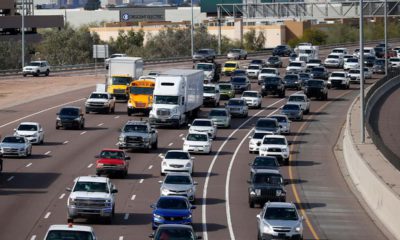Published
6 years agoon
By
Joe Mathews
The road to Mariposa Grove in Yosemite National Park is closed to cars, and the shuttle bus wasn’t running. Would the Three Stooges—my sons, ages 10, 8 and 5—agree to a 2 ½ mile uphill hike to see Yosemite’s signature sequoias?
This month I made my first trip to Yosemite as a father, wondering if my city slicker boys—they like reading, coffee shops and riding the LA. Metro—could handle a visit to the Sierra wilderness.

I shouldn’t have worried. Today’s Yosemite has been changed so much by record crowds, and the limits put in place to control those mobs, that it no longer feels like a place apart. As California has become the state with the highest urban population density in America, Yosemite—with its crowded main valley, choked trails, and tough traffic—fits right in.
For generations, the National Park Service has been trying to reduce the impact visitors have on the park—and with good reason. We humans have been loving Yosemite to death, bearing gifts of everything from pollution to non-native plants.
But the park’s efforts to reduce impacts have followed a familiar California illogic: that restrictions on growth will solve the problems of growth. Just as California’s limits on traffic and housing haven’t prevented increases in people driving or seeking housing, Yosemite’s various limits on visitors, including hiking permits and reservation systems, haven’t reduced the number of people who try to get there.
Indeed, visits to Yosemite have soared to more than five million people annually. In the summer, the massive crowds can create traffic jams worse than anything you’ll find on the 405.
I took my family—Three Stooges, my wife, her parents—to Yosemite at a time when you’re supposed to visit: early spring, before the hordes descend and turn the valley into a parking lot. But the spring imposes its own limits on visitors. Some trails were impassable because of snow. Half Dome Village was shut for repairs from winter storms. Meanwhile, the park had put up signings warning visitors to stay away from El Capitan because of nesting peregrine falcons.
Just like back home, we were never far from a Starbucks, this one in the Yosemite Valley Lodge. And to get around the valley, we squeezed into the free shuttle buses, which must be the most crowded public transit in California, even more cramped than BART at rush hour. 21st-century Yosemite is not for claustrophobes.
My favorite part of Yosemite’s wilderness might have been the lack of reliable Internet access; my phone only really worked in the village. By the second day, my two older boys, missing their Internet video games, started asking when we could “return to the Wi-Fi World.”
I had re-read some of John Muir’s work before the trip, but the naturalist who protected Yosemite has never felt more dead. Muir encouraged direct contact with nature—he climbed an ice wall beneath Yosemite Falls, rode an avalanche, and explored every inch of the place. In today’s Yosemite, you’re constantly reminded to stay on the trails, because your very presence in the place, combined with the carbon-producing existence of humanity, is damaging.
The most recent management plan for the park, from 2014, is full of detailed regulations, including capping the number of people in Yosemite Valley to just over 20,000, but media reports suggest that actual attendance often exceeds that. The park, unfortunately, lacks a truly forward-thinking plan, either to make it vastly wilder or more accessible.
Perhaps the park service could dust off old plans from the 1980s that suggested tearing down buildings, prohibiting vehicles, and relying on futuristic trains to move people around. Or maybe humanity and Yosemite, like partners in a rocky marriage, need a break from each other.
Closing the park for a stretch—5 years? 10 years?—would draw protests. But it would give the park a little time to heal, and to develop extensive plans to better protect this wonderful California place from my family and yours.
Joe Mathews writes the Connecting California column for Zócalo Public Square.


Sierra Nevada Mountains and Foothills Could See Snow Christmas Weekend, Valley Rain Expected


Hail Falls in Fresno as Local Freeze Warning Continues


US Traffic Deaths Fell 2% in 2019; 3rd Straight Yearly Drop


Yosemite, Sequoia & Kings Canyon National Parks All Closing Due To Hazardous Air


Yosemite Closes Mariposa Grove of Giant Sequoias as Creek Fire Precaution


Deadly Wildfire Near Coalinga Is 100% Contained





Leslie Botos
April 27, 2019 at 8:34 pm
A place we loving to death. Yosemite needs time to heal. We must love this special place enough to do what is right to sustain it for many lifetimes.
Kim
May 8, 2019 at 7:11 pm
Closing the park would devastate the local gateway economies that rely on tourist traffic to survive. I’m curious to your thoughts on that?
Already many business’s have been forced to close due to the wild fires in and around the park lowering traffic through those towns.
Should these gateway towns shut down as well?
I feel there is a better answer than a complete shut down. Perhaps your suggestion to use a “train” system in and out of the park. Removing vehicles and the congestion they cause. Anything new will be met with protest. But all things must change.